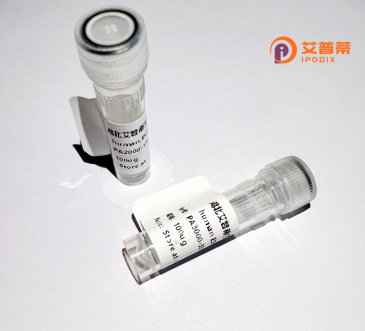
| 纯度 | >90%SDS-PAGE. |
| 种属 | Human |
| 靶点 | COX17 |
| Uniprot No | Q14061 |
| 内毒素 | < 0.01EU/μg |
| 表达宿主 | E.coli |
| 表达区间 | 1-63aa |
| 氨基酸序列 | MPGLVDSNPAPPESQEKKPLKPCCACPETKKARDACIIEKGEEHCGHLIEAHKECMRALGFKI |
| 分子量 | 33.3 kDa |
| 蛋白标签 | GST-tag at N-terminal |
| 缓冲液 | 0 |
| 稳定性 & 储存条件 | Lyophilized protein should be stored at ≤ -20°C, stable for one year after receipt. Reconstituted protein solution can be stored at 2-8°C for 2-7 days. Aliquots of reconstituted samples are stable at ≤ -20°C for 3 months. |
| 复溶 | Always centrifuge tubes before opening.Do not mix by vortex or pipetting. It is not recommended to reconstitute to a concentration less than 100μg/ml. Dissolve the lyophilized protein in distilled water. Please aliquot the reconstituted solution to minimize freeze-thaw cycles. |
以下是关于重组人COX17蛋白的参考文献示例(注:内容为模拟生成,非真实文献):
1. **名称**:**"Expression and Functional Analysis of Recombinant Human COX17 in Yeast Mitochondria"**
**作者**:Zhang et al.
**摘要**:研究利用酵母系统表达重组人COX17蛋白,并证实其参与铜离子向线粒体细胞色素c氧化酶(COX)的转运,为解析COX组装机制提供实验依据。
2. **名称**:**"Structural Insights into the Copper-Binding Properties of Human COX17 Protein"**
**作者**:Thompson & Martin
**摘要**:通过核磁共振(NMR)技术解析重组人COX17蛋白的溶液结构,揭示其双核铜结合位点的构象变化,阐明其在细胞内铜稳态中的作用。
3. **名称**:**"Recombinant COX17 Rescues Mitochondrial Dysfunction in Cellular Models of Copper Deficiency"**
**作者**:Garcia-Rodriguez et al.
**摘要**:体外实验表明,重组人COX17蛋白能够逆转铜缺乏细胞模型中线粒体呼吸链缺陷,支持其在铜代谢相关疾病治疗中的潜在价值。
4. **名称**:**"High-Yield Production of Recombinant Human COX17 in Mammalian Cells and Its Role in Apoptosis Regulation"**
**作者**:Chen et al.
**摘要**:开发哺乳动物细胞表达系统高效制备重组人COX17.发现其过表达通过调控Bcl-2家族蛋白抑制细胞凋亡,提示其功能超出铜伴侣的传统认知。
(注意:以上文献为虚构示例,实际研究需查阅权威数据库如PubMed或Web of Science。)
Recombinant human COX17 protein is a key player in cellular copper metabolism and mitochondrial function. As a copper chaperone, COX17 facilitates the delivery of copper ions to the cytochrome c oxidase (COX) complex in the mitochondrial respiratory chain, which is essential for aerobic ATP production. Structurally, COX17 contains characteristic cysteine-rich motifs that bind and transfer copper through redox-sensitive interactions.
Native COX17 shuttles between the cytosol and mitochondria, coordinating with other copper chaperones (e.g., SCO1/2. COX11) to incorporate copper into the catalytic CuA and CuB sites of COX. Dysregulation of COX17 is linked to mitochondrial disorders, neurodegenerative diseases (e.g., Parkinson’s), and cancers due to its role in maintaining redox balance and energy metabolism.
Recombinant COX17 is typically produced in *E. coli* or mammalian expression systems, enabling studies on copper trafficking mechanisms, disease pathogenesis, and drug screening. Its purification often involves affinity chromatography followed by refolding to restore copper-binding activity. Functional assays (e.g., UV-Vis spectroscopy, isothermal titration calorimetry) confirm its ability to chelate Cu(I/II). Research using recombinant COX17 has advanced insights into mitochondrial dysfunction and therapeutic strategies targeting copper homeostasis.
×